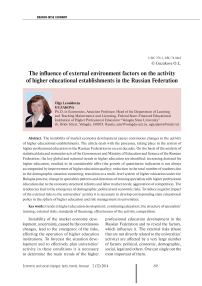The influence of external environment factors on the activity of higher educational establishments in the Russian Federation
Автор: Guzakova Olga Leonidovna
Журнал: Economic and Social Changes: Facts, Trends, Forecast @volnc-esc-en
Рубрика: Branch-wise economy
Статья в выпуске: 2 (32) т.7, 2014 года.
Бесплатный доступ
The instability of market economy development causes continuous changes in the activity of higher educational establishments. The article deals with the processes, taking place in the system of higher professional education in the Russian Federation in recent decades. On the basis of the analysis of statistical data and normative acts of the Government and Ministry of Education and Science of the Russian Federation, the key global and national trends in higher education are identified: increasing demand for higher education, resulted in its considerable offer (the growth of quantitative indicators is not always accompanied by improvement of higher education quality); reduction in the total number of students due to the demographic situation worsening; transition to a multi-level system of higher education under the Bologna process; change in specialties patterns and directions of training specialists with higher professional education due to the economy structural reforms and labor market needs; aggravation of competition. The tendencies lead to the emergence of demographic, political and economic risks. To reduce negative impact of the external risks to the universities' activity it is necessary to develop corresponding state educational policy in the sphere of higher education and risk management in universities.
Trends in higher education development, continuing education, the structure of specialists' training, external risks, standards of financing, effectiveness of the activity, competition
Короткий адрес: https://sciup.org/147223588
IDR: 147223588 | УДК: 378.1 | DOI: 10.15838/esc/2014.2.32.9
Текст научной статьи The influence of external environment factors on the activity of higher educational establishments in the Russian Federation
Instability of the market economy development, uncertainty, caused by the continuous changes, lead to the emergence of the risks, affecting the operation of higher education institutions. To forecast the situation development and to effectively plan universities’ activity in these conditions it is necessary to determine the main trends of the higher professional education development in the Russian Federation and to reveal the factors, which influence it. The external risks (those that are not directly related to the universities’ activity) are affected by a very large number of factors: political, economic, demographic, social, legal and others. One can single out the most important of them.
Firstly, it is necessary to emphasize the changing role of higher education in modern society, where science, information and new technologies are key productive force. Information, penetrating all spheres of life, has become a critical factor in economic growth, affecting production development, efficiency and employment. Computerization of production, introduction of advanced technology and cutting-edge technologies, development of new types of products and services, radically changing production processes, impose at the same time the growing requirements on education and professional training. Informatization of the economy is connected with:
– extension of the information sector industries (production of computing and communication technologies, information services industry, including research centers, consulting firms, centers of scientific-technical information, and so on);
– giving new qualities of production and management at the enterprises of traditional economical sectors;
– creation of a new base to develop small businesses, providing both large and small firms with equal access to information (via the Internet) and extending possibilities of homebased work, flextime and part-time work. The formation of information society is accompanied by significant changes in the sphere of higher education.
First, there is an increase in the level of education of the labor force. The forecast, carried out at the end of the 20th century, revealed that the developed countries in the beginning of the 20th century would transfer to universal higher education, and the rest of the world – by the end of the 2020s [2, p. 8]. In fact, higher education became wide-spread [1, p. 3]. The share of young people, aged from 18 to 25, who are getting higher education, amounts to 80% in the USA, 60% – in Europe, 25% – in China and 15% – in India [13, p. 30]. According to the Rosstat data, in the Russian Federation in 2000 about half of young people, aged 17, were freshmen at higher education institutions, and in 2010 this figure increased to 91% (fig. 1) .
It should be noted that in 2011 the share of 17-year-old youth, entering universities, decreased to 80%. It was caused by the reduction of
Figure 1. Enrolment coefficient to educational establishments of higher professional education in the Russian Federation in 2000–2012, %*
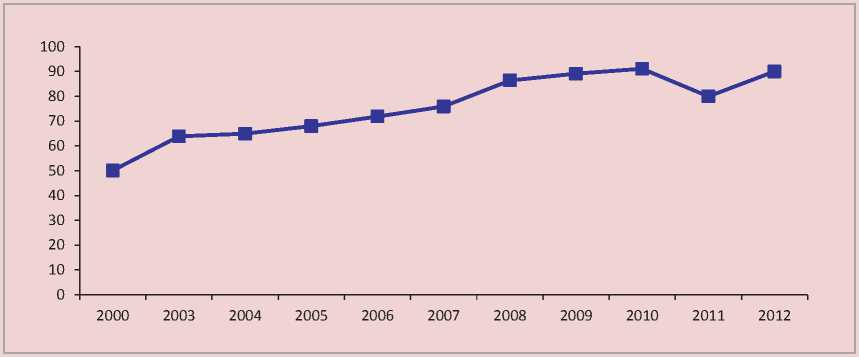
* Enrolment coefficient to educational establishments of higher professional education is defined as a ratio of the people, accepted to educational institutions of higher professional education, to the population at the age of 17 (%).
Source: Osnovnye pokazateli obrazovaniya [Basic Indicators of Education]. Available at: obraz/
enrolment at universities, which fell by 13.7% as compared to 2010, with the number of school leavers being decreased by 11.1%1 (fig. 2) .
In the 2012–2013 academic year the enrolment coefficient to educational establishments of higher professional education in the Russian Federation was 90%, due to higher admission quotas in 2012 [4, p. 560]. This statistics reveals, “firstly, the increase of demand for higher education; secondly, the social capabilities of the state (availability of political will and budget resources, necessary for financing universities); thirdly, the living standard of the population» [13, p. 30].
Research and project competences, formed at the first stage of higher education, presuppose rising popularity of higher education [1, p. 4].
Secondly, nowadays one can notice gradual transition to the system of continuous education, covering the entire period of the employee’s labor ability. The society wants everyone to keep acquiring new knowledge, improving their professional skills, qualification and general culture. So, getting professional education is only the first step in a career. Today education is not focused just on memorizing constantly increasing amounts of information, but on acquiring skills to find data and on developing
Figure 2. Certain indicators of the education system in the Russian Federation, 2000–2012, thousand persons

2000 2005 2008 2009 2010 2011 2012
t Number of leavers of state and municipal general education institutions (not taking into account evening/part-time educational institutions)
■ Admission to educational establishments of higher professional education
Sources: Vypusk obuchayushchikhsya gosudarstvennymi i munitsipal’nymi obshcheobrazovatel’nymi uchrezhdeniyami (bez veche-rnikh (smennykh) obshcheobrazovatel’nykh uchrezhdeniy), 2000–2011 gg. [The Number of Leavers of State and Municipal General Education Institutions (Not Taking into Account Evening/Part-Time Educational Institutions) in 2000 to 2011]. Available at: ru/bgd/regl/b12_14p/; Priem na obuchenie po programmam vysshego professional’nogo obrazovaniya, 1990–2007 gg. [Admission to Study by the Higher Professional Education Programs in 1990–2007]. Available at: bgd/regl/b12_14p/; Priem na obuchenie po programmam vysshego professional’nogo obrazovaniya, 2008–2011 gg. [Admission to Study by the Higher Professional Education Programs in 2008–2011]. Available at: bgd/regl/b12_14p/; Sotsial’no-ekonomicheskoe polozhenie Rossii – 2012 god. Obrazovanie [SocioEconomic Situation in Russia in 2012. Education]. Available at: motivation to continue education and selfeducation. The report of the International Commission on Education for the 21st century “Education: a Hidden Treasure”, presented by UNESCO in the late 1990, stipulates that “the educational ideal of the 21st century differs radically from the classical ideal, based on encyclopedic knowledge. The new educational ideal stands on four pillars: learning to know, learning to do, learning to live together and learning to live” [16, pp. 10-11].
Thirdly, the mobility of students, teachers, and scientific employees of higher education institutions is rising, the national borders are “removing”. Economy globalization leads to increased competition for students (applicants), scientific-pedagogical staff, financial resources (budgetary financing, grants, funds of economic entities to conduct scientific research and others) between universities of different countries. At the same time, universities strive to improve the education quality, using modern technology, including distance, carrying networking cooperation, etc.
The Russian system of higher education is influenced not only by global processes influence, but also by national trends.
First of all, one should highlight the demographic situation worsening, due to decline in fertility in the 1990s, which led to reduction in the number of school leavers at the present time. Since 2005 the number of population, aged 15–24, has continuously decreased by 3% per year (tab.1) .
According to the Federal State Statistics Service, the neutral forecast assumes the decrease by 42.7% in the RF population of the given age for 2002–2020. Rosstat forecasts that the demographic situation in this age group will aggregate till 2021, when the youth population stops decreasing and starts increasing. The growth in the number of young people, aged 15–24 years, will continue throughout the next decade, but even in 2030 the number of the youth in this age group is projected by 5.5% less than in 2013 (tab. 2, fig. 3) .
Changes in the youth population has a strong influence on the number of applicants,
Table 1. Distribution of the RF population, aged 15–24, by age groups in 1989–2012, as of January 1st, thousand persons
Population at age of, years 1989 2002 2004 2005 2007 2008 2009 2010 2011 2012 15–19 9968 12801 12544 12212 11244 10485 9650 8389 8237 7631 20–24 9755 11466 11870 12081 12298 12457 12389 12169 12122 11599 Total 19723 24267 24414 24293 23542 22942 22039 20558 20359 19230 Compiled by: Raspredelenie naseleniya po vozrastnym gruppam [Distribution of the Population by Age Groups]. Available at:
Table 2. Forecast of distribution of the RF population, aged 15–24, by age groups in 2013–2030, as of January 1; thousand persons
Population at age of, years 2013 2015 2017 2019 2021 2022 2024 2026 2028 2030 15–19 7150 6725 6612 6875 7205 7352 7759 8178 8804 8895 20–24 10846 9151 7717 7041 6743 6717 6988 7328 7669 8118 Total 17996 15876 14329 13916 13948 14069 14747 15506 16473 17013 Calculated on the basis of the neutral forecast of the RF population, presented by the Federal State Statistics Service. Source: Chislennost’ naseleniya Rossiyskoy Federatsii po odnoletnim vozrastam. Demograficheskiy prognoz do 2030 goda [Population of the Russian Federation by One-Year Age Groups. Demographic Forecast till 2030]. Available at: rosstat_main/rosstat/ru/statistics/population/demography/#
Figure 3. RF population, aged 15–24 in 1989–2030 as of January 1; thousand persons
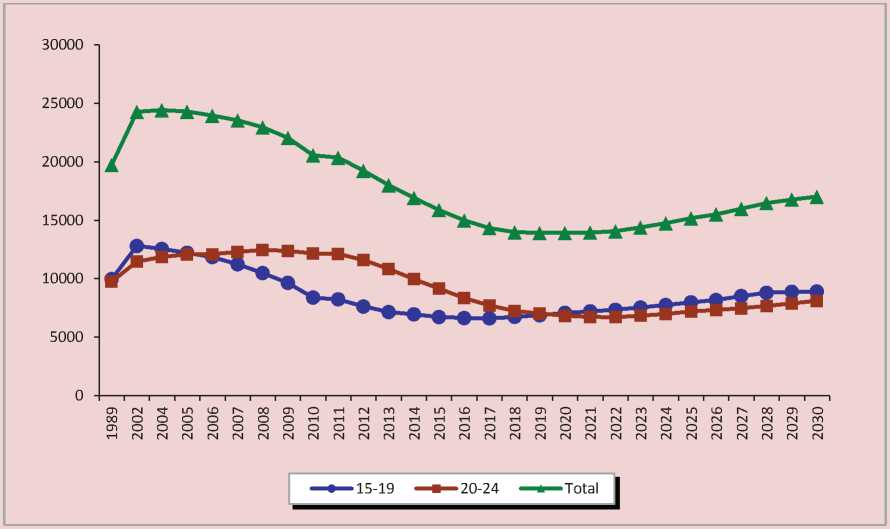
Sources: Raspredelenie naseleniya po vozrastnym gruppam [Distribution of the Population by Age Groups]. Available at: http://www.
but there are not definite correlations between the number of a relevant population group and the number of students, as older people enter universities, choosing part-time education or evening classes. So, despite the fact that the decline in the youth population, aged 15–24, has been observed since 2005, in this period the number of students has been increasing, reaching its peak in the 2008–2009 academic year, and then rapidly began to decline (fig. 4).
The decline in the number of students affected both state and non-state establishments of higher professional education, with the latter experiencing a greater decline. So, in 2012, compared to 2008, the number of students in private institutions decreased by 28.4% (in absolute terms at 368.2 thousand people), while in state universities the drop amounted to 17.2% (1071.0 thousand people). As a result the share of students, admitted to private institutions, decreased by 2% respectively (from 17.3 to 15.3%).
The situation can change due to redistribution of admission to educational institutions of higher professional education in favor of the private sector. So, in the 2012– 2013 academic year enrollment to private establishments of higher professional education rose by a quarter, and admission to state and municipal institutions – only by 5% [17]. The share of the students who have a full refund of tuition: 57.7% – in 2011 and 60.0% – in 2012. The share of the admitted to state and municipal educational institutions of higher professional education with a full refund of tuition was 54% (fig. 5) [17].
The peculiarity of the Russian Federation is the significance of its territory, the multiethnic population and uneven distribution of the population on the territory. This problem is aggravated due to the intensification of migration processes, including those, connected with different development of the education system, primarily of higher education.
Figure 4. Number of students at educational institutions of higher professional education in the Russian Federation in 2000–2012 (as of the beginning of academic year), thousand persons
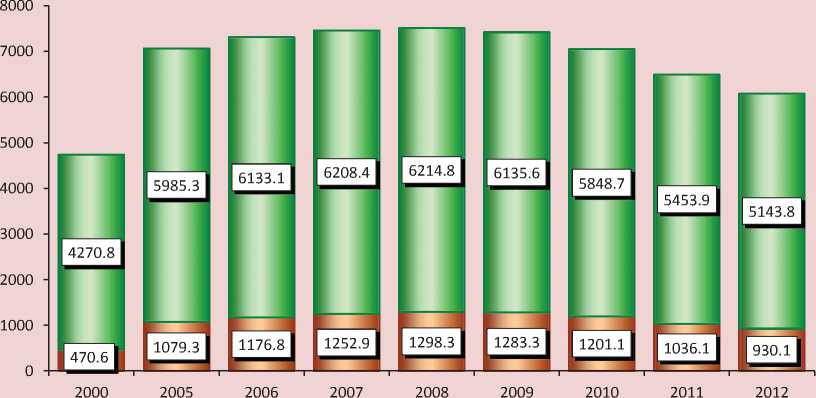
□Including state and municipal educational establishments of higher professional education
□ Non-state educational establishments of higher professional education
Source: Obrazovatel’nye uchrezhdeniya vysshego professional’nogo obrazovaniya (na nachalo goda) [Educational Establishments of Higher Professional Education (for the Beginning of the Year)]. Available at:
Figure 5. Admission to state and municipal educational institutions of higher professional education of the Russian Federation in 2012, thousand persons
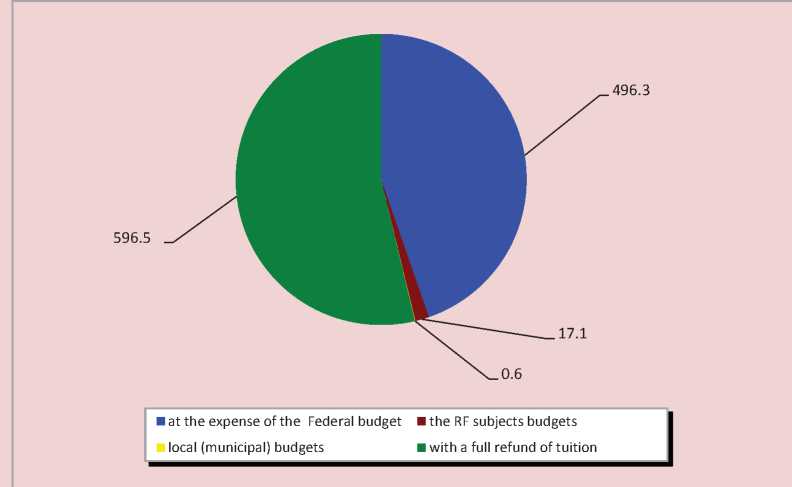
Source: Sotsial’no-ekonomicheskoe polozhenie Rossii – 2012 god. Obrazovanie [Socio-Economic Situation in Russia in 2012. Education].
Available at:
If in 2000 in six Federal districts out of eight, particularly in the Volga, Southern and North Caucasian districts, the share of the accepted to higher educational establishments in the total admission volume throughout the country was less than the share of the leavers of state and municipal educational establishments (not taking into account evening/part-time educational institutions) (tab. 3) in the total number of leavers in the country, in 2011 such a situation was observed only in four Federal districts. This indicates greater opportunities for school leavers to enter universities of their region. However, there are significantly increased disparities between the studied indicators in two Federal districts: the North Caucasian (in 2000, the proportion of school leavers exceeded the proportion of the enrolled in higher education institutions by 1.3%, and in 2011 – by 4.2%) and the Far Eastern (the excess was 0.7% and 1.5%, respectively). The situation can be caused by a reduction of the admission to universities of these districts due to the fact that Unified State Exam was introduced, thus expanding opportunities for young people to enter pres-tigious universities in other regions. This reveals an unequal level of education quality in universities of different RF regions.
Such disproportions cause the necessity of implementing sound state educational policy in Russia, aimed at creating conditions for successful development of firm universities that receive special resources provision. Such educational establishments should contribute to increasing the country’s competitiveness on the global stage and providing equal opportunities for quality education in the regions. According to Kh.G. Tkhagapsoev, “The university strategy should not only seek to “join the list of 100 or 500 best universities in the world”, but to eliminate that dangerous social, economic and cultural gap between regions, ethnic groups
Table 3. Distribution of leavers of state and municipal educational establishments and the accepted to establishments of higher professional education between Federal districts of the Russian Federation in 2000 and 2011, %
Federal District 2000 2011 Leavers of state and municipal educational establishments (not taking into account evening/part-time educational institutions) The accepted to establishments of higher professional education Leavers of state and municipal educational establishments (not taking into account evening/part-time educational institutions) The accepted to establishments of higher professional education Central 23.5 30.0 24.3 29.0 Northwestern 9.3 11.2 8.4 10.6 South 9.5 7.4 9.5 9.0 North Caucasian 5.4 4.1 9.6 5.4 Volga 22.5 19.5 22.2 20.1 Ural 8.6 8.2 6.7 8.0 Siberian 15.8 15.0 13.7 13.7 Far Eastern 5.3 4.6 5.7 4.2 Russian Federation 100.0 100.0 100.0 100.0 Calculated by: Vypusk obuchayushchikhsya gosudarstvennymi i munitsipal’nymi obshcheobrazovatel’nymi uchrezhdeniyami (bez vechernikh (smennykh) obshcheobrazovatel’nykh uchrezhdeniy), 2000–2011 gg. [The Number of Leavers of State and Municipal General Education Institutions (Not Taking into Account Evening/Part-Time Educational Institutions) in 2000 to 2011]. Available at: ru/bgd/regl/b12_14p/; Priem па obuchenie po programmam vysshego professional’подо obrazovaniyal 1990-2007 gg. [Admission to Study by the Higher Professional Education Programs in 1990–2007]. Available at: regl/b12_14p/; Priem na obuchenie po programmam vysshego professional’nogo obrazovaniya, 2008– 2011 gg. [Admission to Study by the Higher Professional Education Programs in 2008–2011]. Available at: b12_14p/ and cultures which is aggravating now. We are talking about problems of “internal” nature. It would be better if in each oblast (republic, krai) at least one University possesses a resource base and technologies of the modern university process” [18, p. 27].
This problem is quite critical due to the necessity to raise universities’ efficiency. In the Federal Target Program of Education Development for 2011–2015 stipulates that “due to demographic reasons and improvement of the educational institutions system the institutions, not included in the number of Federal and national research universities, is to be significantly updated. The typology and structure of a university network is supposed to be adjusted by means of optimization of the number of university branches towards their reduction to some tens of university branches a year. It is also possible to reduce the total universities number by increasing the number of students, getting quality higher education in Federal and national research universities, equipped with modern laboratory facilities” [19]. The Activity Plan (a road map) “Changes in the social sectors, aimed at improving efficiency of education and science”, approved by the order of the RF Government, dated December 30, 2012, no. 2620-r, stipulates that “the enhancement of the structures and networks of state educational institutions of higher education includes: realization of an annual monitoring of the universities efficiency; development, approval and implementation of the program to upgrade the network of state educational institutions of higher education by means of reorganization and amalgamation of the branches; upgrade of the system of licensing and accreditation of educational programs” [10]. Since 2008, when there were the greatest number of universities in the country (1134 units), and the total number of universities in the Russian Federation has decreased by 88 units (or by 7.8%; fig. 6) by 2013 [7].
Figure 6. Number of educational establishments of higher professional education (for the beginning of the academic year)
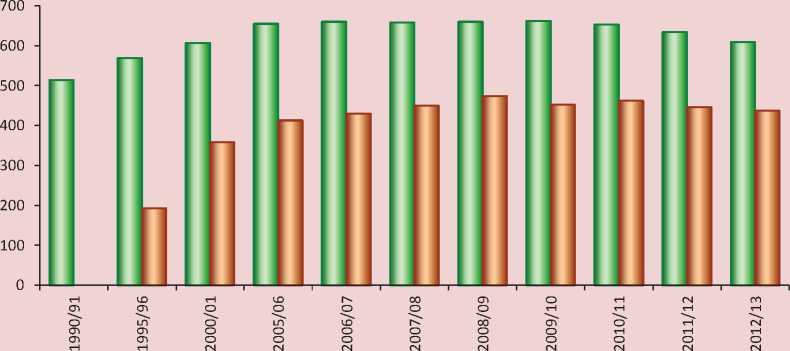
□State and municipal educational institutions of higher professional education □ Non-state educational institutions of higher professional education
Source: Obrazovatel’nye uchrezhdeniya vysshego professional’nogo obrazovaniya (na nachalo goda) [Educational Establishments of Higher Professional Education (for the Beginning of the Year)]. Available at:
The number of public and municipal higher education institutions has decreased by 51 units, non-state – by 37 units. The percentage change in the number of universities of these groups is approximately the same.
In 2012 the number of state and municipal educational institutions of higher professional education decreased by 25 units and nonstate – by 9% [17]. According to the results of the monitoring of universities efficiency, in 2012–2013 22 universities, institutions within jurisdiction of the Ministry of Education and Science and 178 branches were reorganized or supposed to be reorganized [6]. Thus, many universities are challenged by the optimization process of the higher education system, realized by means of amalgamating universities and branches, as well as terminating a license to conduct educational activity.
Since February 1, 2012, the amendments to the RF Law “On education” have come into effect. The non-state institutions of higher and secondary professional education, having the state accreditation, are entitled to participate in the contest for the admission quotas establishment along with state universities [21]. A similar provision is stated in Article 100 of the Federal law “On education in the Russian Federation” no. 273 [22]. The students, admitted to the budget-funded places in non-state accredited higher and secondary educational establishments, have equal rights with students of state higher and secondary educational institutions, particularly in getting scholarship. This measure deprives the state universities of one of their key advantages, the availability of budget-funded places, and boosts competition between institutions, regardless of their form of ownership, thus enhancing the higher education quality.
The Russian economy demands cause changes in the structure of specialties and training directions of specialists with higher professional education. In 1990–2010 there can be distinguished three stages, associated with significant transformations in the sectoral structure of the economy. Thus, the structure of graduates in secondary special and higher education, implemented in the Soviet Union and focused primarily on the needs of manufacturing industries, but not on the demands of social and services spheres, has led to overproduction of technical specialists, which together with the decline in production in the 1990s has caused high unemployment rate among workers in this category. At the same time, in the labor market there was a constant demand for specialists in education, healthcare, consumer services, information systems, lawyers, marketers and managers.
The graduates structure of the Russian Federation and developed countries in the early 1990es differed in the share of engineering and technical specialists, as in Russia it was 4 times higher than in the USA; in the share of agricultural specialists, which in Russia was 15 times higher than in France and 7.5 times – than in the USA; in the share of the human sciences in Russia was 10 times less than in France and 5 times less than in the USA [5, p. 134].
The situation in the labor market, established within the second development stage of professional education in Russia in the late 20th century, resulted in stimulating human sciences development, while putting aside engineering and agricultural sciences.
The third phase, which began in the 1990s, is connected with the change of the objectives of the Russian economy development. To boost innovativeness, technical re-equipment and production competitiveness has become a new goal. Hence, the admission quota for economic, human and social sciences was reduced. The number of budget-funded places remained steady at engineering and technical sciences, including those that correspond to the priority directions of modernization and technological development of the Russian economy [8, p. 31].
Significant changes also occur in the course of study (fig. 7) . Though there are such courses of study as full-time, part-time (evening), correspondence and external, the majority of students prefer full-time and correspondence courses.
The time line of 1985–2010 can be divided into three periods by the dynamics of the total number of students in Russian universities and the course of study. The first period, since 1985 to 1992, is marked by a significant decrease in the total number of students (by 12%) and their number at all courses of study, except full-time [14, p. 106]. In 1993, the share of full-time study was highest possible – almost 64%. The second period, since 1992–1994 to 2006–2008, is characterized by almost threefold increase in the total number of students, decline in the share of full-time education and rise in the proportion of correspondence education. In 2008 the number of students of full-time education was less than part-time for the first time in Russia. The third period, started in 2006–2008, is marked by decline in the overall number of students, decline in the share of full-time education and increase in the share of correspondence education. It is mostly characteristic for non-state higher educational institutions; in 2010 there were less than 18% of full-time students and almost three quarters of correspondent students [14, p. 107]. The increase in the number and share of correspondent students is explained by less financial expenditure.
This trend will continue in the coming years. The “road map” stipulates the reduction in the total number of students by 20.7% in the sphere of higher education by 2018 (compared
Figure 7. Number of students of different courses of study at educational institutions of higher professional education (in 1995–2013, thousand persons)
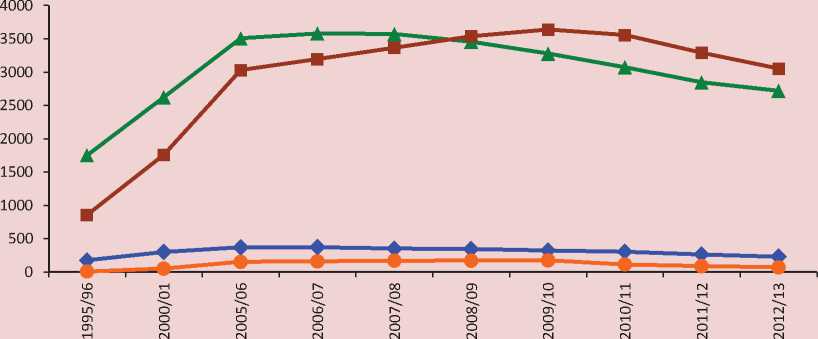
* Number of full time students
—^—Number of part-time students (having evening classes )
— ■ —Number of correspondent students
• Number of external students
Source: Obrazovatel’nye uchrezhdeniya vysshego professional’nogo obrazovaniya (na nachalo goda) [Educational Establishments of Higher Professional Education (for the Beginning of the Year)]. Available at: to 2012) planned and the described group of students – by 28.2%2, thus indicating further change in the students structure, with the full time education being decreased and other courses of study, most likely, correspondence education, being increased (fig. 8)3. Correspondence education presupposes fewer number of class hours, hence the time of direct communication between students and professors goes down and the share of independent goes up. Moreover nowadays, unlike the Soviet period, it not necessary to work within specialty, you are getting as a correspondent student. Thus, the education quality of graduates is reduced. Therefore, to ensure the required quality of correspondence education, it is necessary to use new technologies, distance education with an appropriate educational support, etc.
Thus, in the higher education system one can highlight the following trends:
– increased demand for higher education, which led to greater proposal (the growth of quantitative indicators is not always accompanied by the quality improvement of higher education);
– decrease in the total number of students, due to demographic situation deterioration;
– growing imbalances between RF regions in opportunities to get high quality education;
– reduction in the share of students, enrolled in non-state institutions;
– introduction of higher education levels, shifting to a bachelor degree system and master’s degree programs, while retaining a specialist’s degree system;
– change in the specialities structure and directions of training in the system of higher professional education, due to economic restructuring and labor market needs. For the last 3–5 years it has included more budget-funded places for the most demanded specialities in accordance with the RF priority directions of development of science and technologies, and reduction in admissions quota for human and economic sciences;
– optimization of the network of universities, involving the reduction of their number;
– decline in the share of full-time study and growth of part-time education for almost two decades.
Identification of these trends gives an opportunity to characterize some risks of development of higher professional education system. First of all, it is a high level of political risk, associated with various events and governmental decisions that affect education. Among them, one should mention Russia’s joining European educational space, transition to tier system of education, optimization of the network of universities, including creation of Federal and research universities, allocation of budget-funded places to non-state universities, etc. These decisions are aimed at increasing competitiveness of Russian universities; however the negative impacts are possible, due to uncertain conditions of their accepting.
Economic risks are risks, arising from changes in the economy. According to the Federal law, “On amendments to certain legislative acts of the Russian Federation due to improvement of the legal status of state (municipal) institutions” dated May 8th, 2010, no. 83, budget financing of the university is provided not by means of a balance sheet, but by means of a government grant, with the number of people, who chose the educational program, being taken into account [20]. Concurrently, there are risks, associated with the reduction of per capita financing, due to decrease in the number of students
Figure 8. Change in basic quantitative characteristics of higher education system in 2012–2018, in % by 2012
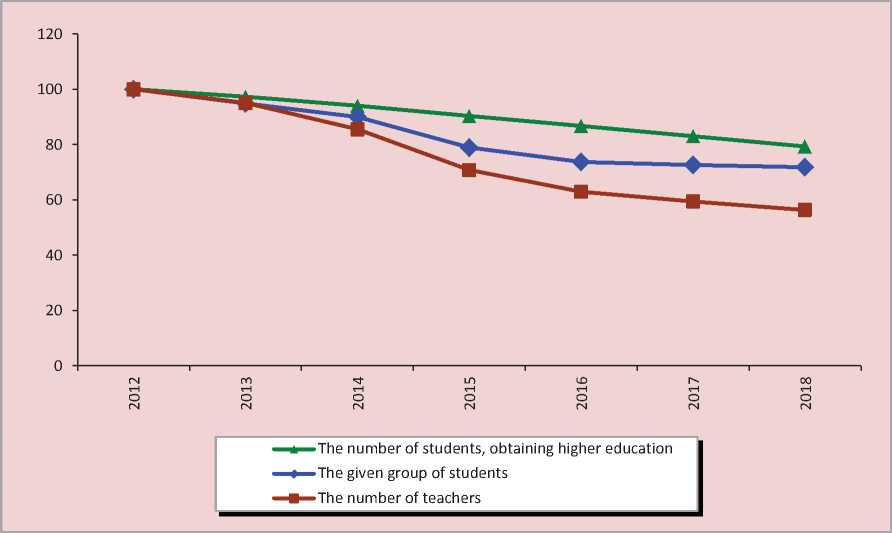
Source: Plan meropriyatiy (dorozhnaya karta) “Izmeneniya v otraslyakh sotsial’noy sfery, napravlennye na povyshenie effektivnosti obrazovaniya i nauki”: utverzhden rasporyazheniem Pravitel’stva RF ot 30.12.2012 №2620-r [The Activity Plan (the Roadmap) “Changes in Social Sphere, aimed at Improving Education and Science”: Approved by the RF Government Decree of December 30, 2012 No. 2620-r]. Available at:
against the background of the demographic crisis, and also due to expel of students. The university faces a challenge. On the one hand, it can expel students, who do not cope with the requirements of the state educational standards, thus decreasing education quality of graduates. On the other hand, it can maintain a high level of requirements to students and expel those who do not cope with them, thus getting fewer allocations from the budget. Introduction of standard financing can ensure the growth of competition between educational institutions and increase state universities’ freedom in using funds.
One of the consequences of the state education policy is reduction in the number of qualified teachers. The number of academic teaching staff will reduce by 43.7% in 2018
compared to 2012. The greatest decrease is forecasted for 2015, when the number of academic teaching staff will decrease by 17% compared to the previous year (calculated by the activity plan and the road map [10, p. 88]). This change is caused by the reduction in the number of students, the last graduation of specialists with a 5-year term of study under the State Educational Standard of Higher Professional Education, and the first graduation of bachelors with a 4-year term of study under the Federal State Education Standard of Higher Professional Education. Most universities will experience a transition from a five-year to a four year term of study. Moreover, higher educational establishments can expect the rise in a standard teacher-student ratio from 1:9.4 in 2012 to 1:12 in 2018 [10, p. 88].
The elaborated changes will inevitably lead to reduction in the number of academic teaching staff, thus the educational institutions will lose their competitiveness in the market of educational services, unless they increase the level of qualification of the teaching staff gradually.
Thus, the educational services market experiences intensified competition between state and non-state higher education institutions, primarily, between those that implement the same programs, as well as between institutions of higher and secondary professional education. A university, seeking a stable position in the educational services market, should manage market risks, that is identify, assess and minimize their negative consequences.
Список литературы The influence of external environment factors on the activity of higher educational establishments in the Russian Federation
- Belotserkovskiy A.V. Rossiyskoe vysshee obrazovanie: o vyzovakh i riskakh . Vysshee obrazovanie v Rossii , 2012, no.7, pp. 3-9.
- Volkov Yu.A., Subetto A.I., Chekmarev V.V., Volkov A.Yu., Sidlo A.A. Obrazovanie i intellektual'nyy potentsial Rossii. Statistiko-sotsiograficheskiy kvalimetricheskiy monitoring vosproizvodstva . Moscow: Kostroma, 1998. 176 p.
- Vypusk obuchayushchikhsya gosudarstvennymi i munitsipal'nymi obshcheobrazovatel'nymi uchrezhdeniyami (bez vechernikh (smennykh) obshcheobrazovatel'nykh uchrezhdeniy), 2000-2011 gg. . Available at: http://www.gks.ru/bgd/regl/b12_14p/IssWWW.exe/Stg/d01/06-08.htm
- Guzakova O.L. Tendentsii razvitiya vysshego professional'nogo obrazovaniya v Rossiyskoy Federatsii . Integratsiya v formate Soyuznogo gosudarstva kak osnovnoy instrument realizatsii strategii bezopasnosti Rossii i Belarusi. Mezhdunar. nauch.-prakt. konf.: materialy vystupleniy , Vologda: ISERT RAN, 2013, ch. 2, pp. 558-566.
- Krol' V., Krasnushkin E., Nazarova T. Mirovye sistemy vysshego obrazovaniya: sravnitel'nyy analiz professional'noy struktury vypuskov . Vysshee obrazovanie v Rossii , 1996, no.2, pp. 130-138.
- Monitoring effektivnosti deyatel'nosti obrazovatel'nykh organizatsiy vysshego obrazovaniya i ikh filialov: Materialy k soveshchaniyu s uchastiem rektorov podvedomstvennykh Minobrnauki Rossii vuzov, 10 iyunya 2013 goda . Available at: http://minobrnauki.rf/novosti/3441
- Obrazovatel'nye uchrezhdeniya vysshego professional'nogo obrazovaniya (na nachalo goda) . Available at: http://www.gks.ru/free_doc/new_site/population/obraz/vp-obr1.htm
- O planirovanii ob"emov podgotovki kadrov s professional'nym obrazovaniem i nauchnykh rabotnikov (kontrol'nye tsifry priema), 2013, no.4, pp. 25-34.
- Osnovnye pokazateli obrazovaniya . Available at: http://www.gks.ru/free_doc/new_site/population/obraz/obr-svod1.htm
- Plan meropriyatiy (dorozhnaya karta) “Izmeneniya v otraslyakh sotsial'noy sfery, napravlennye na povyshenie effektivnosti obrazovaniya i nauki”: utverzhden rasporyazheniem Pravitel'stva RF ot 30.12.2012 №2620-r . Available at: http://www.rg.ru/pril/76/89/67/2620_plan.pdf
- Priem na obuchenie po programmam vysshego professional'nogo obrazovaniya, 1990-2007 gg. . Available at: http://www.gks.ru/bgd/regl/b12_14p/IssWWW.exe/Stg/d01/06-26-1.htm
- Priem na obuchenie po programmam vysshego professional'nogo obrazovaniya, 2008-2011 gg. . Available at: http://www.gks.ru/bgd/regl/b12_14p/IssWWW.exe/Stg/d01/06-26-2.htm
- Prikhod'ko V.M., Solov'ev A.N. IGIP i tendentsii inzhenernoy pedagogiki v Rossii i v mire , 2013, no.6, pp. 26-32.
- Pugach V.F. Raspredelenie rossiyskikh studentov po formam obucheniya . Vysshee obrazovanie v Rossii , 2013, no.3, pp. 98-107.
- Raspredelenie naseleniya po vozrastnym gruppam . Available at: http://www.gks.ru/wps/wcm/connect/rosstat_main/rosstat/ru/statistics/population/demography/
- Savel'ev A., Romanova L. Obudushchey doktrine vysshego obrazovaniya . Vysshee obrazovanie v Rossii , 1998, no. 3, pp. 10-11.
- Sotsial'no-ekonomicheskoe polozhenie Rossii -2012 god. Obrazovanie . Available at: http://www.gks.ru/bgd/regl/b12_01/IssWWW.exe/Stg/d12/3-5.htm
- Tkhagapsoev Kh.G. Na putyakh v mirazhi? (K sovremennym strategiyam razvitiya obrazovaniya v Rossii) , 2012, no.7, pp. 21-28.
- Federal'naya tselevaya programma razvitiya obrazovaniya na 2011-2015 gg. . Available at: http://www.fcpro.ru/the-concept-of-the
- Federal'nyy zakon “O vnesenii izmeneniy v otdel'nye zakonodatel'nye akty Rossiyskoy Federatsii v svyazi s sovershenstvovaniem pravovogo polozheniya gosudarstvennykh (munitsipal'nykh) uchrezhdeniy” ot 08.05.2010 goda №83 . Available at: http://www.consultant.ru/document/cons_doc_LAW_140527/
- Federal'nyy zakon “O vnesenii izmeneniy v otdel'nye zakonodatel'nye akty Rossiyskoy Federatsii v chasti ustanovleniya imeyushchim gosudarstvennuyu akkreditatsiyu obrazovatel'nym uchrezhdeniyam srednego professional'nogo i vysshego professional'nogo obrazovaniya kontrol'nykh tsifr priema grazhdan dlya obucheniya za schet sredstv sootvetstvuyushchikh byudzhetov byudzhetnoy sistemy Rossiyskoy Federatsii”: ot 16.11.2011 №318 . Available at: http://www.consultant.ru/search/
- Federal'nyy zakon “Ob obrazovanii v Rossiyskoy Federatsii” ot 29.12.2012 №273 . Available at: http://graph.document.kremlin.ru/page.aspx?1646176
- Chislennost' naseleniya Rossiyskoy Federatsii po odnoletnim vozrastam. Demograficheskiy prognoz do 2030 goda . Available at: http://www.gks.ru/wps/wcm/connect/rosstat_main/rosstat/ru/statistics/population/demography/#

